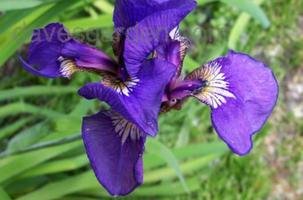





Boy meets girl, boy loves girl, and boy and girl get married, have kids, and live happily ever after?. right? Not so in the world of iris. Let?s take a little look at the ins and outs of breeding your own iris.
Why Breed Iris?
Why even try? With all the world of iris out there the chances of you ever getting something really worth selling on the market today are slim. I have heard estimates from some breeders of up to 100 plants are culled out just to find one that might, in time, be named and sold on the market. So why do it? Why spend so much time, effort, garden space, and resources just to have a sub par plant that will end up compost for the next batch of iris you try to raise? The answer, of course, is the joy of finding one great iris to call your own. It is the wonder and spell casting power in the first bud of a plant you raised up from a little seed. It is the waiting, hoping, and praying that the little seed you planted a few years back will now open up into the stunning flower you just knew it had inside. So what do you have to lose? Give it a try!
How to Breed.
Long story short is to play the part of a bee and take a little pollen from flower “a” to flower “b”. If it were only that simple everyone would be breeding iris. You need to wake up in the early morning hours just when the flowers are starting to open. After all, you need to make the match before Mother Nature gets in there and gets herself in the mix. Taking a paint brush, go over the pollen producing areas of one iris and, ever so carefully, walk to the second iris you have your eyes set on. But wait--you say it did not open today? Don’t give up! Place that little paint brush tip in a small plastic baggie and label it well with the date, time, and flower you borrowed the pollen from. Place the baggie in the freezer. This does not always work but it is worth it to try that cross you have been dying for. When the mother flower opens and is ready for business just take out the baggie and give the soon to be mother a good brushing.
What to Look For
Only take pollen from winners in your garden. That sickly small plant with almost no flowers over there, while tempting if you are bored, will most likely pass on those same traits to the babies you are trying to grow. Look for the plant that grows the way you love. Look for increasing size each year, strong stalks, and high bud count. Find the traits you want to pass on to the next iris and use those plants.
Parents do Matter
The parents of the iris in your garden, who were they? If you don’t breed iris you might never have thought about them. But once you start to breed iris you will start thinking about who the parents of iris are. Why think about the parents? The traits the parents have or do not have will also be in the mix of what will soon be their grandbabies. Looking into the linage of any iris will give you a better idea who they are and what they can give the iris world.

How do I know if I have a winner?
You just will. No one can tell you when you have an iris ready for the market. There is not a bar you must place your iris up against. There is no magic wand to wave over the top and see it is ready. You can and should post your baby here in the Iris forum and you will see, once you think it is ready, there will be others who think so too. Once it is named and listed in the Plant Files you will be ready to sell or trade your new iris.
I want to thank Pajaritomt, Jackieshar, Avmoran, Irisloverdee, Happygarden, and Doss for answering my many research questions for this article. Thank you to Weezingreens for the images for this article.
Gardening Against The Trend: Heirloom Seeds Part 1
Lawn Mower Blades are the most vital part of the lawn mower
Do You Know What Is The Male Part Of The Flower?
Ever Wondered What Is The Male Part Of The Flower?
A large and colorful family, the Acanthaceae (Part II)
Anemone, the Windflower: Part 3 - The Fall-flowering Species and Hybrids
Introduction to Tree Aloes, part 1: the solitary, unbranched species
Copyright © www.100flowers.win Botanic Garden All Rights Reserved